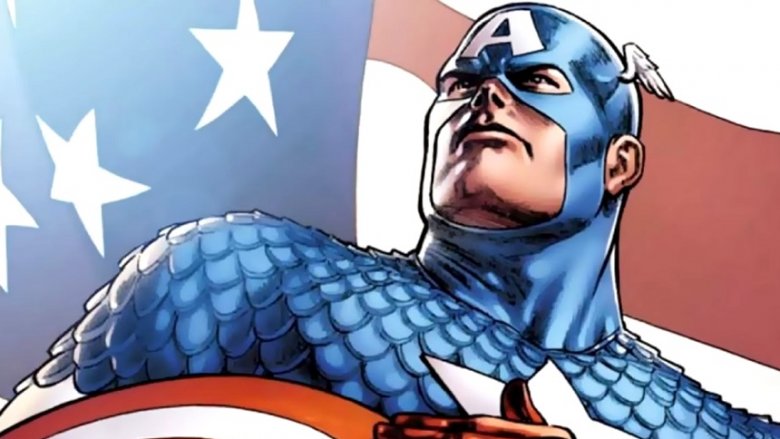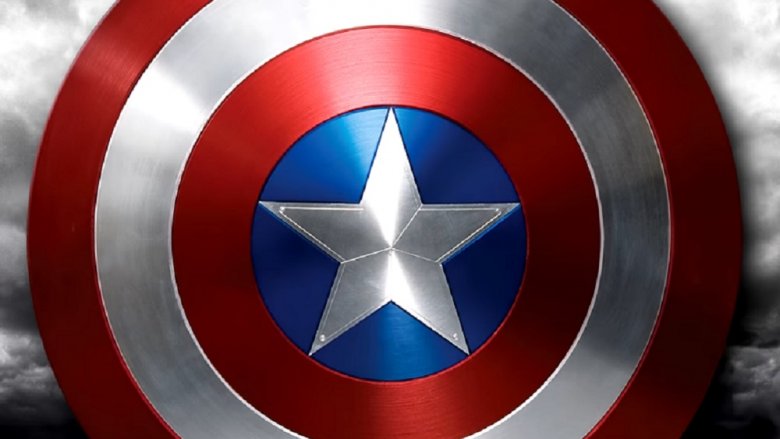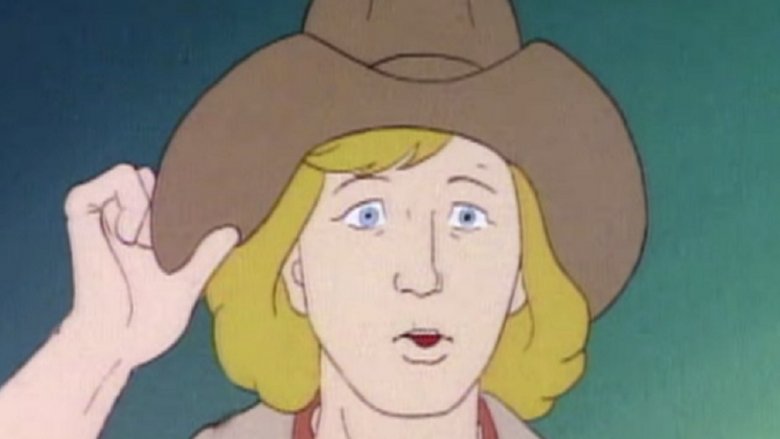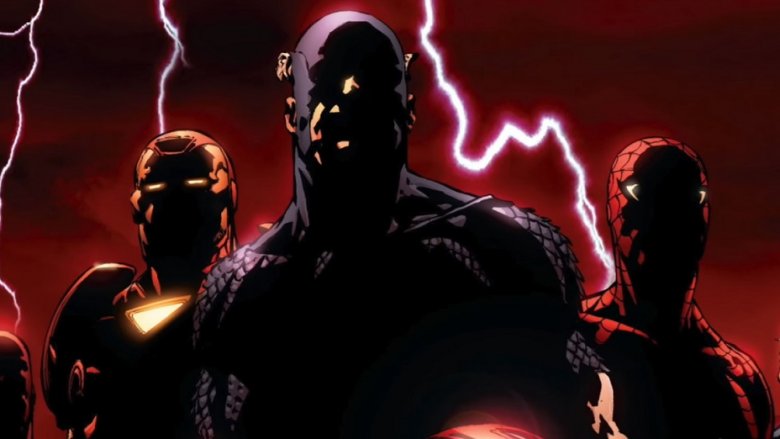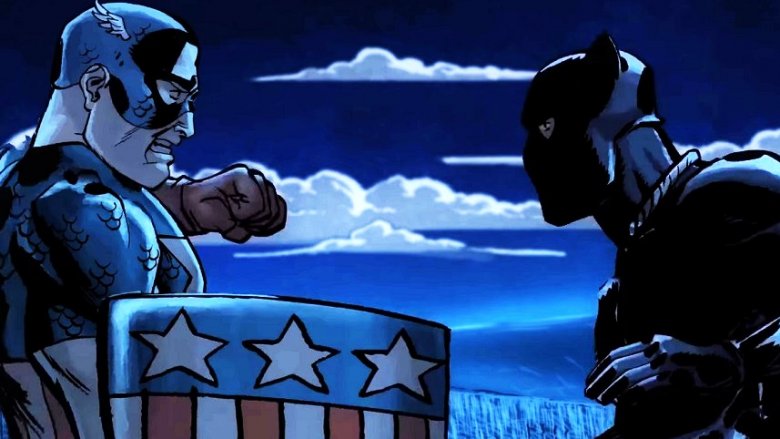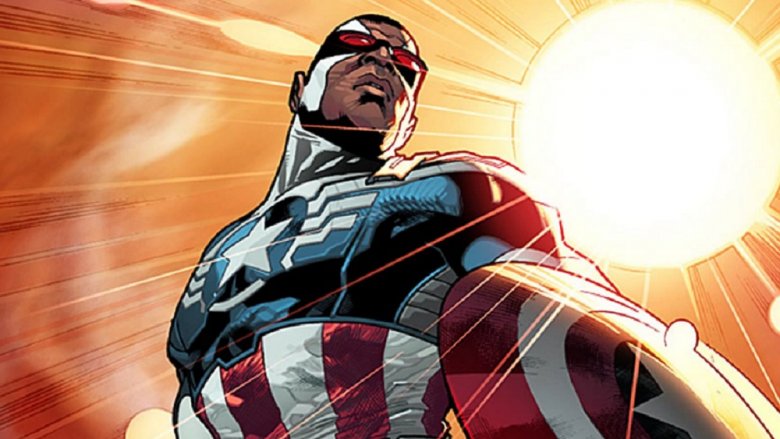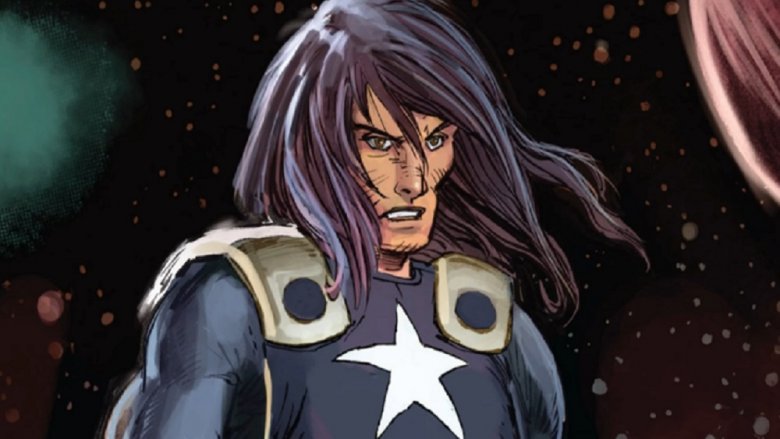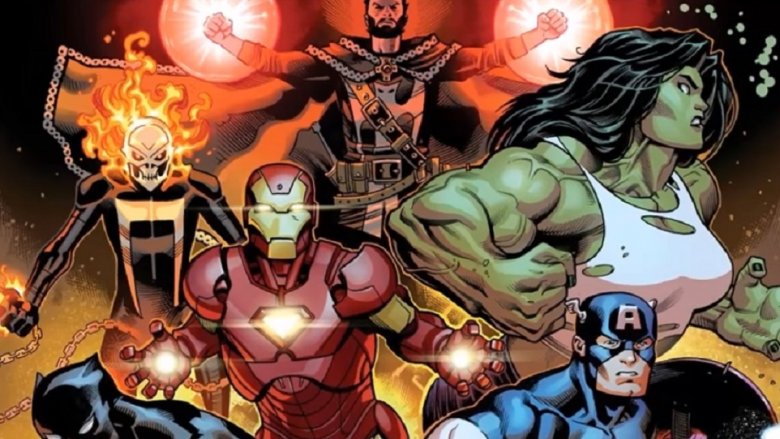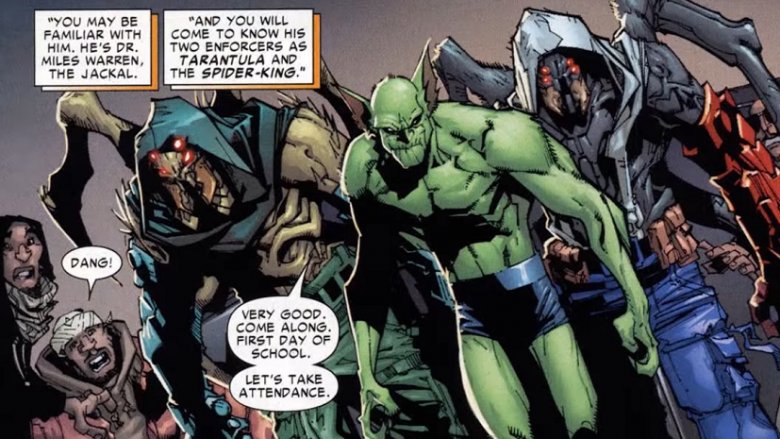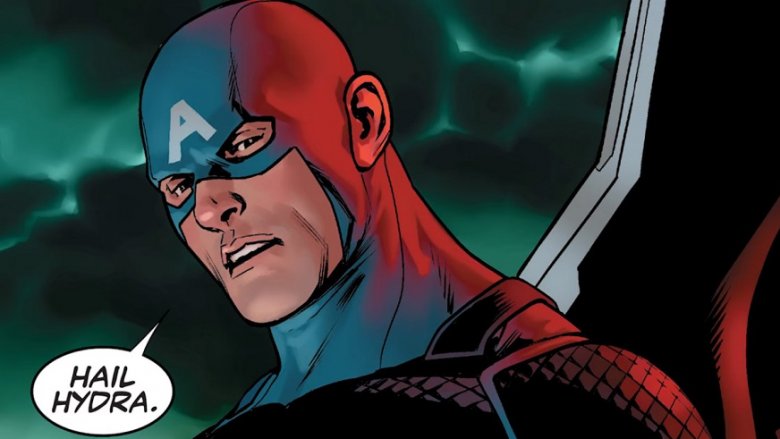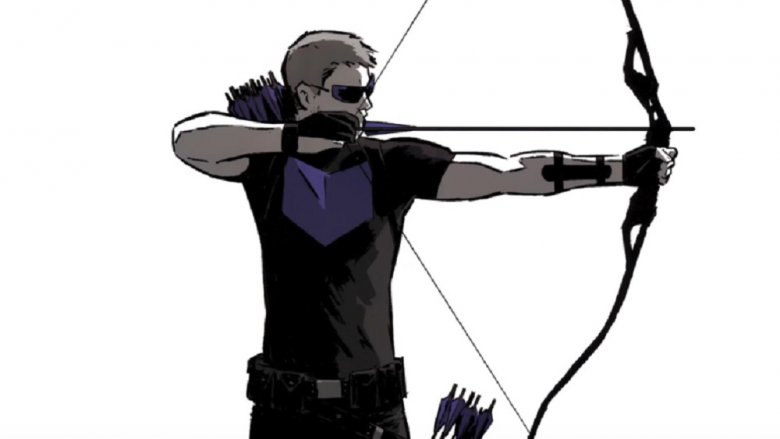The Untold Truth Of Captain America
Steve Rogers, the World War II hero and perennial Avenger known as Captain America, has been a cultural icon since he was famously introduced punching Adolf Hitler in the face on the cover of Captain America Comics #1, published by Timely Comics (the predecessor to Marvel) in late December of 1940. From the very first sketch of the character created by artist Joe Simon, Cap's iconic red, white and blue image has remained largely the same — although he did undergo a fortunate name change before being declared ready for publication. Simon had originally thought to call the character "Super American," but changed his mind because "there were too many 'Supers' around," and "there weren't a lot of captains in comics."
We all know that Rogers beat the tar out of Nazis throughout the war, spent years at the bottom of the ocean as a Capsicle, and returned to become the heart and soul of multiple incarnations of Earth's Mightiest Heroes, the Avengers, wielding his nigh-unbreakable shield and a will just as strong. But since any character with nearly a century of history will inevitably have some interesting details fall through the cracks, let's take a look at some lesser-known aspects of the consummate leader and tactician, the embodiment of the best possible version of American ideals, the star-spangled man with a plan: Captain America.
Note: some information is sourced from the Marvel Encyclopedia, 2014 Updated and Expanded Edition.
His shield isn't solid vibranium
Cap's shield is perhaps the most iconic tool in any superhero's arsenal; not only is it virtually indestructible, it can absorb vast amounts of kinetic energy, which is why it can withstand blows from the Hulk or Thor's hammer Mjolnir without simply sending Cap flying. In the Marvel Cinematic Universe, this is due to its composition of pure Wakandan vibranium, a rare and versatile metal of alien origin with energy-absorbing properties — but in its original comic incarnation, the shield isn't pure vibranium. It's an alloy of the Wakandan metal and several other exotic materials, created by a lazy government employee in a metallurgical accident.
Scientist Myron Maclain was tasked by the U.S. government with the creation of a super-strong metal to be used in tanks, and one night while laboring over the project, Maclain fell asleep. He awoke to find that the materials he'd been working with had mysteriously bonded, and cast the new substance using a disc-shaped mold for tank hatches. The government gifted Cap with the shield after he'd proven his mettle in the field, and Maclain was never able to duplicate the process which created it — although repeated attempts would years later result in the creation of adamantium, the famously strong metal of which Wolverine's skeleton is made. Adamantium replicas of Cap's shield would be employed for various purposes over the years, but Cap always preferred the real deal — and like the super-soldier himself, it can never be duplicated.
Bucky wasn't his only young partner
Almost as well-known as Cap himself, original sidekick Bucky Barnes was an orphaned child, a mascot at the military base where Rogers was stationed in the early days of the war. Rogers himself was undercover at the base as a bumbling private, but when Bucky discovered his secret, Rogers took the kid under his wing, training him in his unique fighting style. Bucky (who, of course, would later return in modern times as the Winter Soldier) was presumed dead along with Cap in the fateful plane crash over the English Channel that led to Cap's hibernation — and when the Avengers retrieved Rogers from the ice, he took a liking to another young protege.
Teenager Rick Jones was directly involved in the accident which created the Hulk, and it was his distress call which initially caused the Avengers to form to deal with the green menace. Having been taken in by the team as an honorary member, Jones answered the call when Cap found himself in need of another partner, undergoing combat training and even, for a time, wearing Bucky's old uniform. While his status as Cap's sidekick was short-lived, Jones would go on to adventures on a cosmic scale. He acted as the vessel for the Kree alien Mar-Vell (the original Captain Marvel), and was even transformed by Hulk nemeses M.O.D.O.K. and the Leader into a blue, Hulk-like being known as A-Bomb.
He trains every Avenger
Captain America is among the finest hand-to-hand combatants in the Marvel Universe, and not only because of his vast experience, training, and enhanced strength and reflexes. His indomitable will to win is virtually unmatched, making him an incredibly formidable opponent even for super-powered beings who are far stronger than he. As such, practically every hero who has come through the Avengers' revolving door undergoes extensive training in unarmed combat from Rogers — even those with such unorthodox fighting styles as Spider-Man and Quicksilver.
In fact, the list of Marvel Universe denizens who have come under Cap's tutelage is ridiculously extensive, and not limited to Avengers or even superheroes. Among his more interesting students: none other than Mary Jane Watson, who has used her Cap-imparted knowledge to fend off numerous non-superpowered attackers over the years, including the supervillain Chameleon. From the invincible Iron Man to the savage She-Hulk to the Scarlet Witch — one of the most powerful beings in the entire Marvel Universe — there's no hero too mighty to benefit from Rogers' unparalleled expertise in beating the absolute hell out of any opponent they might face.
He was briefly replaced by Black Panther
Having access to the knowledge of all the Black Panthers who came before him and utter mastery of virtually every fighting style on Earth (including several of his own creation), King T'Challa of Wakanda is among the only unarmed combatants in the Marvel Universe who rivals Cap in sheer expertise. In Avengers #47, Cap decides to take a leave of absence from the team to set off on his own adventures — and one of those adventures would bring him to Wakanda, where he would encounter perhaps his only viable replacement in the Black Panther.
After helping Cap to foil a plot by Baron Zemo to destroy the US using advanced weaponry, T'Challa accompanies him back to America, mulling over Cap's suggestion to join the Avengers as his replacement. It wouldn't take long for this to come to fruition, as T'Challa finds the team apparently dead (but actually placed into comas) at the hands of the supervillain Grim Reaper upon his first visit to Avengers HQ. Initially suspected of the deed, the Panther manages to escape police custody and defeat the Reaper, securing his coma-inducing device and reviving the Avengers. The grateful team makes T'Challa a full-fledged member, and Cap would only make cameo appearances in Avengers comics until returning to the team a full three years later.
His best friend began as an enemy
Sam Wilson, the Falcon, has been perhaps Cap's staunchest friend and ally over the years. Their formal partnership began way back in 1971, with Captain America #133, and Wilson has even periodically received second-billing in Cap's own ongoing series. But strangely, their long association never would have happened if Wilson hadn't first been recruited to attempt to kill the super-soldier — by none other than Cap's arch-nemesis, the Red Skull.
After his plane crashed on a remote island, Wilson — along with his pet falcon, Redwing — was discovered by a Cosmic Cube-wielding Skull, who used the power of the Cube to give Wilson the superpower of telepathic communication with birds (and an especially strong link with Redwing), and manipulate him into attacking Captain America. The skirmish didn't go as the Skull had planned, however, as Cap managed to break Wilson free of the villain's hold and convince him to help take the Skull down. Dubbing himself the Falcon, Wilson began a life of crime-fighting alongside the star-spangled Avenger — but he wouldn't truly live up to his moniker for another few years. In Captain America #170, Cap commissioned a jet-powered, titanium flying harness for Wilson from his friend the Black Panther, enabling Wilson to become Cap's airborne backup. Wilson, along with Bucky Barnes, would famously go on to take on the mantle of Captain America himself — but they weren't the only two to pick up the shield over the years.
Nomad, "The Captain," and the other Captain Americas
The golden era of Cap's comic book run saw him taking part (with the Avengers) in the ancient war between the Kree and rival alien race the Skrulls, joining forces with Mar-Vell to take on the Mad Titan Thanos, and traveling to the 31st century to fight the hostile race of aliens known as the Badoon alongside the first iteration of the Guardians of the Galaxy. But on two separate occasions, Cap became disillusioned enough with the machinations of his government that he dropped the Captain America identity — and both times, others tried to step into the role with varying degrees of success.
During the time Steve Rogers was operating under the alias Nomad, soldiers Bob Russo, "Scar" Turpin, and Roscoe Simons were tapped to carry the shield. While the first two bailed after realizing just how perilous the job was, Simons was endorsed by Rogers himself — but met a gruesome end at the hands of the Red Skull, forcing Rogers to return as Captain America to end the Skull's murderous wrath. Later, wracked by fear of compromising his principles, he surrendered the official Captain America role to John Walker, the Super-Pat riot, in favor of operating independently as "The Captain." Walker even kept Cap's shield during this time, while Rogers used adamantium and vibranium replicas provided by Tony Stark and T'Challa, respectively. But until Barnes took on the role following Rogers' "death" during the Civil War, none lasted too long — although Walker went on to a distinguished career as costumed hero U.S. Agent.
He has "Full Champion License"
In the comics as in the films, Cap has had a long and complicated relationship with the American intelligence agency S.H.I.E.L.D. and its director, Nick Fury. While Rogers understands the importance of following orders as well as any soldier, his resolute unwillingness to bend his principles has brought him into conflict with the organization on more than one occasion. There is, however, one credential bestowed by S.H.I.E.L.D. that nobody other than Rogers is known to possess: "full champion license," which is exactly as far-ranging as it sounds.
As revealed in New Avengers #1, the license grants Rogers the unfettered authority to "assemble any team [he sees] fit to go on any mission [he sees] fit." Even Maria Hill, one of the highest ranking S.H.I.E.L.D. officers, is blindsided by this revelation. The traditional Avengers team had recently been disbanded following Scarlet Witch's horrific mental breakdown, and after an incident at supervillain prison the Raft wherein nearly every villain housed there escaped, Cap formed the New Avengers — more of a loose network of heroes with no formal base of operations — to deal with such threats in the future. Their roster has included the likes of Iron Man, Spider-Man, Doctor Strange, Luke Cage, Wolverine, and the godlike but highly unstable being known as the Sentry.
He almost helped destroy the world
Professor Miles Warren — a longtime nemesis of Spider-Man — was instrumental in the Clone Saga, one of the more controversial storylines in Marvel's history. A brilliant scientist, Warren went insane after killing his assistant and took on the new, viciously evil persona of the Jackal in order to separate his actions from himself and ease his guilty conscience. After several failed attempts to destroy Spider-Man, Warren decided on a novel strategy: the creation of a "Spider-Virus" which could be spread through infected arachnids and which would give the afflicted all the power of Spidey, with none of the responsibility.
As the Jackal's "Spider-Men" wreaked havoc on Manhattan, Warren experimented on a captured Steve Rogers, mutating him into a hideous creature which he dubbed the Spider-King. Key to his strategy: "impregnating" Rogers with thousands of eggs, then allowing this abomination to be apprehended by Flash Thompson (Peter Parker's onetime bully, who had bonded with the Venom symbiote to become Agent Venom) and transported to S.H.I.E.L.D. headquarters, where the eggs hatched. Fortunately, Agent Venom was able to deal with the situation, and Rogers was placed into suspended animation until a cure for his condition could be found. But if not for Thompson's intervention, Rogers would have been instrumental in Warren's plan to use an army of Spider-Men to bring the world to its knees.
"Hydra Cap" was actually the real Cap... sort of
In 2016, Marvel used the relaunch title Captain America: Steve Rogers to introduce the most insanely controversial plot twist in a long history full of them. At the issue's end, Cap suddenly turns on and murders his sidekick Jack Flag before uttering two words which had Cap fans the world over reeling in shock: "Hail HYDRA." Speculation ran rampant that "HYDRA Cap" must be some kind of fakeout, which he was ... sort of.
After a brutal assault by Crossbones which had left him near death, Cap had recently been restored to peak health by Kobik — a S.H.I.E.L.D. project which was essentially the Cosmic Cube in a sentient form. But unbeknownst to the agency, the Cube had been indoctrinated in the ways of HYDRA by the Red Skull during the time he had been in possession of it, and in restoring Rogers, Kobik had rewritten Cap's history to conform to the Skull's indoctrination. For a time, HYDRA Cap was indeed the true Cap, with the original Rogers only existing within Kobik's memory — which might have remained the case forever when the cube was shattered. But HYDRA Cap initiated his own undoing by tracking down the fragments and reassembling the cube, allowing Bucky Barnes to pull his friend's memory from Kobik's mind into physical reality — at which point Rogers did what he does best, and roundly defeated his fascist counterpart.
Nobody else can throw his shield properly except Hawkeye
It's a common misconception that Cap's shield must be equipped with some kind of technology to make it return to him like a boomerang, but this isn't the case. The shield's ability to absorb and disperse kinetic energy means that once bounced off an object, it will basically keep bouncing forever until caught, and Cap's understanding of its properties — plus his complete mastery of battle physics bestowed by the super-soldier serum — enable him to predict its flight path with unerring accuracy. Handling it properly is practically a superpower unto itself, to the point where even the two most accomplished heroes to take up Cap's mantle — Sam Wilson and Bucky Barnes — both struggled mightily to learn how to use it as an offensive weapon, even with extensive training from Rogers.
However, there is one Avenger for whom handling the shield wasn't much of a problem: Clint Barton (Hawkeye), perhaps the only hero whose mastery of physics and ballistics is on par with Cap's. After Cap's apparent assassination during the Civil War event, Barton — then using the alias Ronin — was offered the shield and the mantle of Captain America by Tony Stark, after Barton was found to be literally the only one who could handle it proficiently. He declined, leaving the role to eventually be filled by Barnes — but even Cap's oldest and closest friend had a tougher time with Cap's weapon of choice than the most underrated Avenger.
